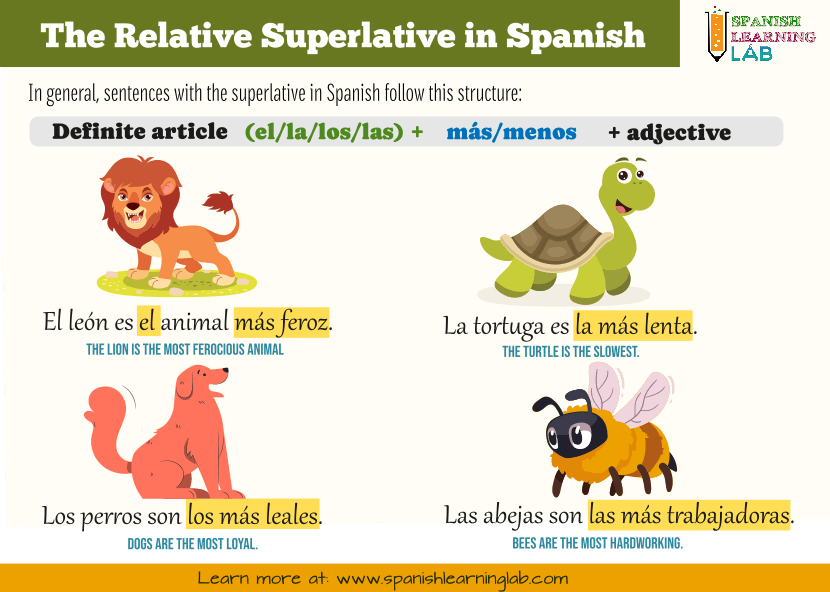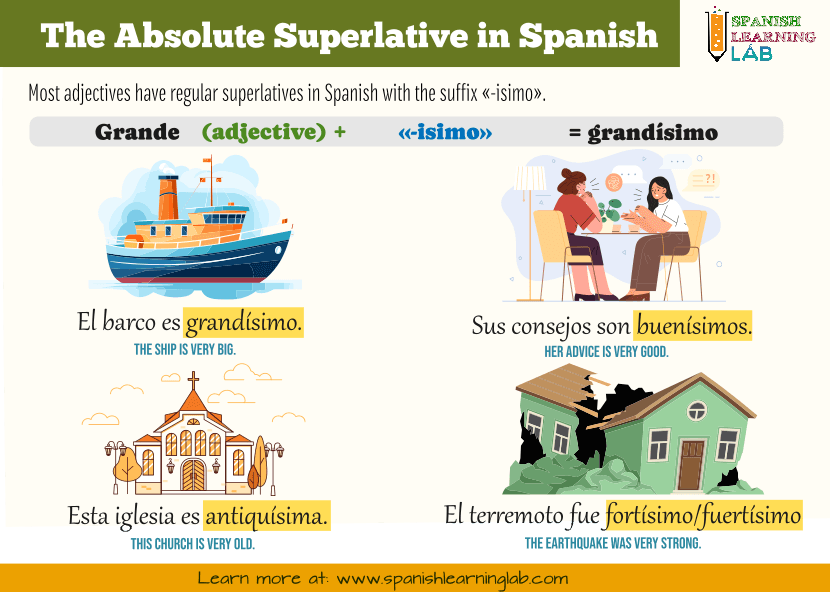Thanks for joining us in this lesson. This time, we will cover the rules for using superlatives in Spanish. We will explore how to make comparisons using the superlative of Spanish adjectives through several examples and will test your understanding of the rules with a practical interactive quiz. Manos a la obra…
The basic rules for the relative superlative in Spanish: “El más…”
The relative superlative in Spanish is used to differentiate an object from a group by maximizing its qualities or minimizing them. It is very similar to their English counterpart for saying things like “The most interesting” or “The happiest”. Here are the key rules to use the relative superlative:
First, we have to find a definite article (el, la, los, las) that agrees in number and gender with the main noun in the sentence. Remember that “EL” will be used for masculine, singular nouns like “Pedro”, “LA” for singular, feminine words like “CASA” or “AMIGA” and so on. Take a look at these examples:
- Paco es el más inteligente. (Paco is the most intelligent one.)
- Su casa es la más bonita. (Her house is the most beautiful.)
- Las fresas de esta finca son las más populares. (The strawberries from this farm are the most popular.)
Second, we need to use the words “MÁS” or “MENOS” which are equivalent to “MORE/MOST” and “LESS/LEAST” respectively from the English language. For the superlative, we will place “MÁS” just after the definite article, like this:
- El más bonito. (the most beautiful)
- La más interesante. (the most interesting)
- Los menos caros. (the least expensive)
- Los menos útiles. (the least useful)
Third, unlike the English language, there is no need to add any suffix to form the superlative in Spanish of short adjectives like “ALTO” or “CARO”. We just need to find the right definite article and add the word “MÁS”, for example:
- Short adjectives: Francisco es el más alto de la clase. (Francisco is the tallest in our class.)
- Long adjectives: Este experimento es el más complicado de todos. (This experiment is the most complicated of all.)
Finally, unlike English, it is very common to add a noun between the article “EL” and the adjective, e.g. “El perro más leal“. You can also add the noun after the adjective, but it will sound too formal and would be more suitable for poetry, for example:
- Normal speech: “El niño más creativo” (The most creative kid)
- Suitable for poetry: “El más creativo niño” (The most creative kid.)
Take a look at the examples shown in the picture below using the structure for relative superlatives in Spanish to describe animals in nature:

Examples of sentences using superlatives in Spanish
|
Fernando es el más alto de la clase.
Fernando is the highest in the class.
|
|
Alejandra es la más joven del grupo.
Alejandra is the youngest of the group.
|
|
China es el país más poblado del mundo.
China is the most populous country in the world.
|
|
Thiago es el bebé más hermoso del mundo.
Thiago is the most beautiful baby in the world.
|
|
Esta es la casa más bonita del barrio.
This is the most beautiful house in the neighborhood.
|
|
Él escribió algunos de los libros más famosos del siglo pasado.
He wrote some of the most famous books of the last century.
|
|
Lo más importante es terminar a tiempo.
The most important thing is to finish on time.
|
|
Este es el lugar menos apropiado para discutir ese problema.
This is the least appropriate place to discuss that issue.
|
Forming the absolute superlative in Spanish with the suffix –ísimo
It is time to study the second form of superlatives in Spanish: the absolute superlative. In this case, something or someone has the best or the worst qualities without even comparing them to the rest of a group. This type of superlative in Spanish can be formed by using the adverb “MUY” (very), for example: “Alan es muy inteligente”. In this example, we are not comparing Alan with anybody else, but simply highlighting that he is very smart. As you can see, the structure looks a lot similar to the one from English, and it is easy to replicate.
However, sometimes instead of using any of the structures above, you will hear people say things like “Ella es hermosísima” instead of “Ella es muy hermosa”. The word “hermosísima” comes from adding the suffix “-ísima(o)” to the adjective’s ending as a way to maximize a physical feature or personality trait. Spanish absolute superlatives with –ísimo come handy when talking about outstanding qualities or flaws in something or someone, which makes this structure more suitable for personal opinions. Notice that the suffix -ísimo will always need tilde on the first “i”, and you will also need to match the new adjective to the noun you are describing in gender and number, just like this:
- El edificio es altísimo. (The building is very tall.)
- Ana es altísima. (Ana is very tall.)
- Los precios de los productos son altísimos. (The prices of the products are very high.)
- Las flores están altísimas. No podrás alcanzarlas. (The flowers are very high. You won’t be able to reach them.)
Listen to and analyze the next group of sentences using the absolute superlative in Spanish:
|
Él es rapidísimo para escribir.
He is very quick to write.
|
|
Ramiro es altísimo. Es tan alto como una jirafa.
Ramiro is very tall. He is as tall as a giraffe.
|
|
El huracán Irma fue fuertísimo.
Hurricane Irma was very strong.
|
|
¿Qué opinas de la clase de matemáticas? – Que está dificilísima.
What do you think about math class? – That is very difficult.
|
As you can see in the examples above, we will drop the last vowel for words ending in vowels like “rapido” (fast) or “dulce” (sweet), so instead of saying “rapidoísimo”, we will say “rapidísimo” or “dulcísimo”. Similarly, for adjectives ending in “-ia/io” like “amplio” (broad), we will drop the ending and just add the suffix to say “amplísimo” (very broad) Also, some adjectives like “Fuerte” (strong) have two different superlatives in the language: “fortísimo” and “fuertísimo”, being “fuertísimo” more commonly used. Finally, a couple of these words come from Latin, so for an adjective like “antiguo”, we should not say “antigüísimo“, but “antiquísimo“, according to the rules.

The absolute superlative in Spanish may be a bit tricky, but it is very useful. You can always double-check online to see whether you are saying something right or not. Know, even as native speakers, we grow up saying “La iglesia es antigüísima” instead of “La iglesia es antiquísima“, so don’t worry, practice always makes perfect.
Interactive quiz: Superlatives in Spanish
Related Spanish Worksheets:
- Let’s talk about Favorites in Spanish – Conversation cards
- Impressive Places and Superlatives in Spanish (Reading exercises)
